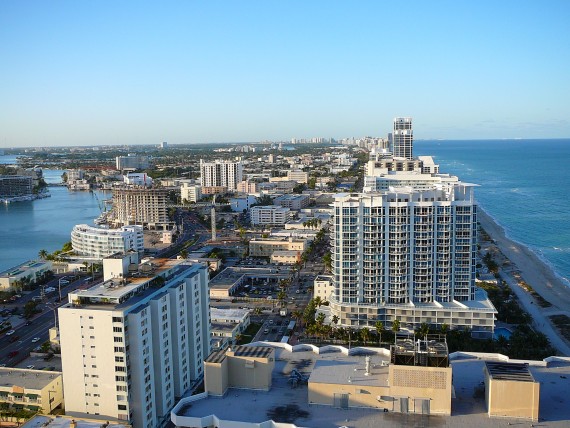Miami’s residential real estate sector is still sending mixed signals, though one seems clear: don’t expect many broken sales records in 2016.
The city — including luxury enclaves on both the mainland and Miami Beach — experienced a big slowdown in sales activity during the final quarter of 2015, while pricing trends swayed depending on the neighborhood, according to fourth quarter 2015 Elliman reports.
For Miami, the data shows one major trend: the residential market has slowed.
“The market has transitioned out of this sort of frenzied situation from the last couple years to something that’s not as robust,” Jonathan Miller, president of Miller Samuel and author of the report, told The Real Deal.
Coastal mainland
On Miami’s coastal mainland, which includes markets east of I-95, sales fell significantly year-over-year. A total of 1,876 single-family homes traded during the fourth quarter, down almost 14 percent compared to the same time period in 2014.
Condos fared similarly: 2,225 units were sold at the end of 2015, down 16.1 percent from the previous year.
Miller said much of that slowed activity is due to fewer distressed sales. Now that the housing economy has seen several years of recovery, foreclosures and short sales have gradually been flushed from the market by stronger homeowners who typically pay cash.
Distressed condo sales on the mainland were down a whopping 41 percent year-over-year: 466 distressed units traded in the fourth quarter, compared to 790 in 2014.
And the numbers for distressed single-family homes told a similar story. There were nearly 39 percent fewer sales year-over-year — down to 482 at the end of 2015, compared to 786 the prior year.
Not all of the market’s slowdown is due to a lack of distressed properties, though. A strong U.S. dollar has had a chilling effect on purchases from wealthy foreigners, whose own currencies have been flailing as much of the global community heads toward another economic slump. Those currency trends mean it becomes pricier for a foreigner to pick up U.S. real estate, which can work against a property’s attractiveness as an investment or as a safe place to park money.
Meanwhile, prices for a single-family homes on the mainland hit a bump in the road during 2015’s fourth quarter: homes sold for an average of $419,614 at the end of the year, down 5.6 percent from the previous quarter — even though home prices are up compared to last year. While home prices fell, condo prices held steady during the fourth quarter. The average sales price of a unit was $343,123 — down a fraction of a percent quarter-to-quarter, and falling by 1.5 percent year-over-year.
On top of these reduced sales figures is a huge influx of new condos hitting the market. There were 8,259 units listed for sale during the fourth quarter, up 12 percent from the year before.
With all those new units to choose from, Miller said people tend to take longer before making a purchase decision — which could explain why units are selling much more slowly compared to the hotter years of 2013 and 2014.
Single-family homes actually experienced the opposite trend in 2015’s final few months: there were 3,327 properties on the market during the fourth quarter, marking a 7.4 percent reduction in inventory year-over-year.
“The sense of urgency is not the same,” Miller said. “That’s the period we’re in now — it’s not this frenetic pace that we’ve grown accustomed to over the past three or four years.”
Miami Beach
While the mainland has begun slowing, its ritzy island counterpart is facing more troubling numbers.
Sales for both condos and single-family homes in Miami Beach were down significantly and new inventory continues to surge into the market.
For condos, there were almost 29 percent more new listings at the end of 2015 compared to the previous year. A total of 4,512 units were listed for sale during the fourth quarter, up from the 3,504 listed in the same timeframe during 2014.
Miami Beach’s listings marked the singular upward trend for condos. Condo sales totaled 765 units during the fourth quarter, nearly a 20 percent drop from the 950 sold at the end of 2014.
Average prices have also started to curve downward. The average closing price for a unit was $695,325 — a 10 percent decrease from the fourth quarter of 2014.
On the other hand, prices for single-family homes have practically exploded. The average closing price for a Miami Beach house was a whopping $3.35 million during the fourth quarter — that’s a 67.3 percent increase from the year before.
That pricing surge could explain the next two trends: only 80 Miami Beach homes sold during the fourth quarter, nearly 28 percent fewer from the final months of 2014.
Meanwhile, almost 37 percent more homes were for sale at the end of 2015. The number of active homes for sale grew from 480 in 2014 to 656 during 2015. Attractive pricing can pull sellers into the market.
All that new inventory has pushed Miami Beach’s absorption rate to 17.7 months for condos and 24.6 months for single-family homes. For reference, a healthy market is said to typically hover between six and nine months.
But these figures aren’t necessarily heralding another recession. Miller said the market could be correcting itself after years of overheated activity.
“The market has shifted to the next stage where there’s stabilized pricing and a lower level of sales activity,” he said. “It’s a more sustainable pace than what we had a year ago. It’s just unclear how long we’ll be in this period.”
